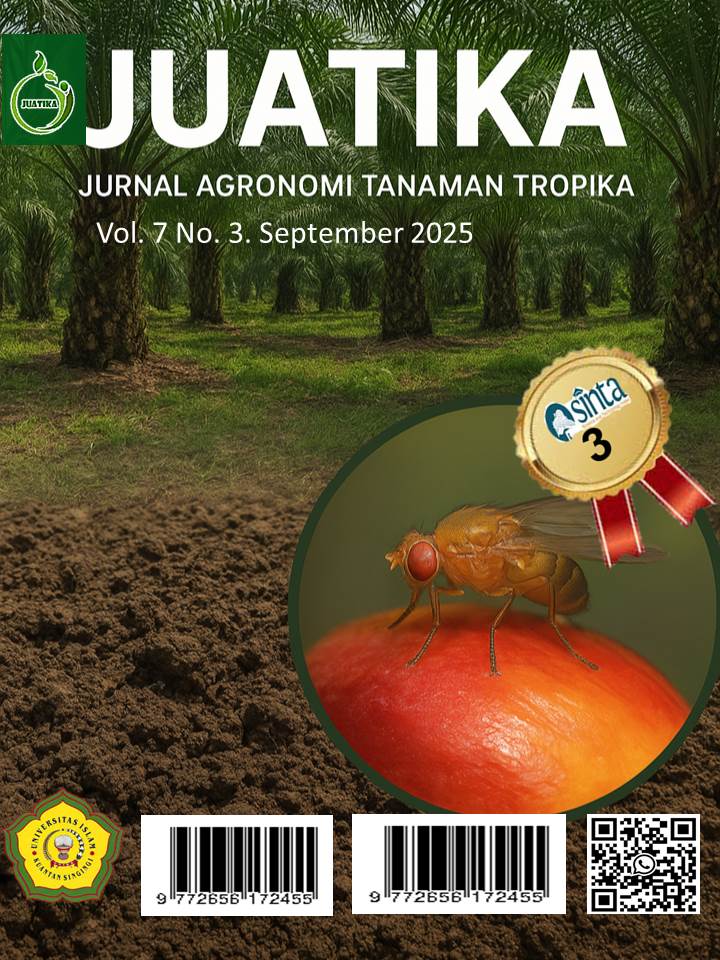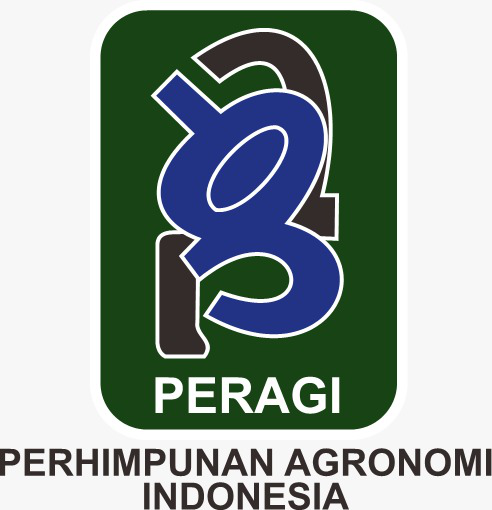In Vitro Mutation Induction of Chrysanthemum (Chrysanthemum morifolium) Maruta Variety for Lowlands Using EMS (Ethyl Methane Sulfonate)
Abstract
Chrysanthemums (Chrysanthemum morifolium) are among the most popular ornamental plants due to their diverse types, shapes, and colors, making them highly valued in the horticultural market. In Indonesia, chrysanthemums are typically grown in highland regions, where production and flower quality are declining due to global temperature changes. To sustain production, new varieties adapted to lowland conditions are required. This study aimed to induce mutations in the Maruta chrysanthemum variety using Ethyl Methane Sulfonate (EMS) to enhance adaptability and biodiversity. Explants were treated in vitro with EMS concentrations of 1%, 1.5%, and 2%. Quantitative traits—including survival percentage, explant height, number of shoots, leaves, and roots—were analyzed using ANOVA and Tukey's test at the 5% level. Qualitative traits, such as stem and leaf color, were assessed using the Munsell Color Chart. Results showed that more than 50% of Maruta explants survived under all treatments. However, explant height, number of leaves, and number of roots decreased as EMS concentration increased, compared with the control.
Downloads
References
Alfikri, M. S., Nilahayati, N., Handayani, R. S., Nazimah, N., & Hafifah, H. (2022). Potensi peningkatan keragaman genetik tanaman kedelai (Glycine max (L.) Merr.) akibat pemberian mutagen EMS (ethyl methane sulfonate) pada fase vegetatif. Jurnal Ilmiah Mahasiswa Agroekoteknologi, 1(3), 73–76. https://doi.org/10.29103/jimatek.v1i3.9758
Andriyani, & Muslihatin, W. (2017). Pengaruh mutagen kimia EMS terhadap perkembangan bunga tanaman cabai (Capsicum frutescens var. bara). Sains dan Seni ITS, 6(2), 22–24. https://doi.org/10.12962/j23373520.v6i2.24007
Krupa-Małkiewicz, M., Oszmiański, J., Lachowicz, S., Szczepanek, M., Jaśkiewicz, B., Pachnowska, K., & Ochmian, I. (2019). Effect of nanosilver (nAg) on disinfection, growth, and chemical composition of young barley leaves under in vitro conditions. Journal of Integrative Agriculture, 18(8), 1871–1881. https://doi.org/10.1016/S2095-3119(18)62146-X
Hidayat, Y. V., Apriyanto, E., & Sudjatmiko, S. (2020). Persepsi masyarakat terhadap program percetakan sawah baru di Desa Air Kering Kecamatan Padang Guci Hilir Kabupaten Kaur dan pengaruhnya terhadap lingkungan. Naturalis: Jurnal Penelitian Pengelolaan Sumberdaya Alam dan Lingkungan, 9(1), 41–54. https://doi.org/10.31186/naturalis.9.1.12230
Indrawanis, E. (2025). Response of total number of tillers, plant height, and dry straw weight of Jangguik rice genotypes (Oryza sativa) with gamma ray irradiation treatment. Jurnal Agronomi Tanaman Tropika (JUATIKA), 7(1), 289–293. https://doi.org/10.36378/juatika.v7i1.4126
Irawan, G., Nilahayati, N., Nazimah, N., Handayani, R. S., & Nurdin, M. Y. (2023). Pengaruh pemberian EMS (ethyl methane sulfonate) terhadap pertumbuhan kedelai (Glycine max (L.) Merr.) galur M.1.1.3. Jurnal Ilmiah Mahasiswa Agroekoteknologi, 1(4), 87–90. https://doi.org/10.29103/jimatek.v1i4.10462
Kamila, N., Purnomo, S. S., Widyodaru, N., & Sandra, E. (2022). Induksi mutasi etil metan sulfonat (EMS) terhadap kenampakan fenotip anggrek ki aksara (Macodes petola) secara in vitro mutation induction of ethyl methane sulfonate (EMS) to phenotypic appearance of the Ki Aksara orchid (Macodes petola) in vitro. Jurnal Agrohita, 7(1), 152–162. https://doi.org/10.31604/jap.v7i1.5917
Pratama, W. M., Indrawanis, E., & Nopsagiarti, T. (2024). Micropropagation of orchids (Cattleya sp.) by adding plantain extract and activated charcoal to MS media in vitro. Jurnal Agronomi Tanaman Tropika (JUATIKA), 6(2), 657–664. https://doi.org/10.36378/juatika.v6i2.3670
Putra, B. S., & Purwani, K. I. (2017). Pengaruh mutagen kimia EMS (ethyl methane sulphonate) terhadap daya berkecambah benih tanaman tembakau var. Marakot. Jurnal Sains dan Seni ITS, 6(2), E89–E92. https://doi.org/10.12962/j23373520.v6i2.26705
Atikabudi, R. D., Sukendah, S., & Widiwurjani, W. (2022). Pengaruh EMS dan paklobutrazol terhadap pertumbuhan dan pembungaan krisan (Chrysanthemum morifolium) di dataran rendah. Agrium: Jurnal Ilmu Pertanian, 25(2), 174–180. https://doi.org/10.30596/agrium.v25i2.11330
Romiyadi, R., Komariah, A., & Amien, S. (2018). Keragaan tiga jenis planlet anggrek Phalaenopsis asal protocorm yang diinduksi ethyl methyl sulfonate (EMS) secara in vitro. Kultivasi, 17(1), 596–607. https://doi.org/10.24198/kultivasi.v17i1.16077
Qosim, W. A., Yuwariah, Y., Hamdani, J. S., Rachmadi, M., & Perdani, S. M. (2015). Pengaruh mutagen etil metan sulfonat terhadap regenerasi tunas pada dua genotip manggis asal Purwakarta dan Pandeglang. Jurnal Hortikultura, 25(1), 9–14. https://doi.org/10.21082/jhort.v25n1.2015.p9-14
Tantasawat, T. P., Khairum, A., Tharapreuksapong, A., Poolsawat, O., & Tantasawat, P. A. (2017). Molecular characterization of Dendrobium ‘Earsakul’ mutants from in vitro selection for black rot resistance. Journal of Applied Horticulture, 19(2), 130–134. https://doi.org/10.37855/jah.2017.v19i02.23
Copyright (c) 2025 Abigail Febby Puspo Harijono, Sukendah, Pangesti Nugrahani, Ragapadmi Purnamaningsih

This work is licensed under a Creative Commons Attribution 4.0 International License.
Authors who publish with Jurnal Agronomi Tanaman Tropika (JUATIKA) agree to the following terms:
Authors retain copyright and grant the Jurnal Agronomi Tanaman Tropika (JUATIKA) right of first publication with the work simultaneously licensed under a Creative Commons Attribution License (CC BY 4.0) that allows others to share (copy and redistribute the material in any medium or format) and adapt (remix, transform, and build upon the material for any purpose, even commercially) with an acknowledgment of the work's authorship and initial publication in Jurnal Agronomi Tanaman Tropika (JUATIKA).
Authors are able to enter into separate, additional contractual arrangements for the non-exclusive distribution of the journal's published version of the work (e.g., post it to an institutional repository or publish it in a book), with an acknowledgment of its initial publication in Jurnal Agronomi Tanaman Tropika (JUATIKA). Authors are permitted and encouraged to post their work online (e.g., in institutional repositories or on their website) prior to and during the submission process, as it can lead to productive exchanges, as well as earlier and greater citation of published work.







 More Information
More Information



